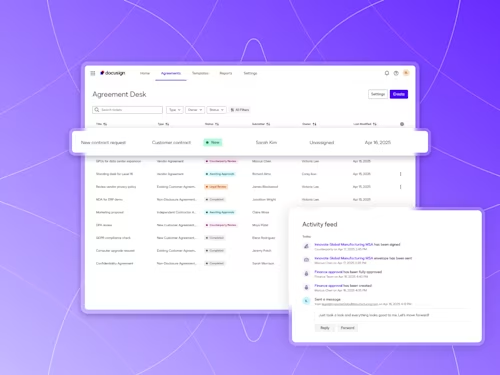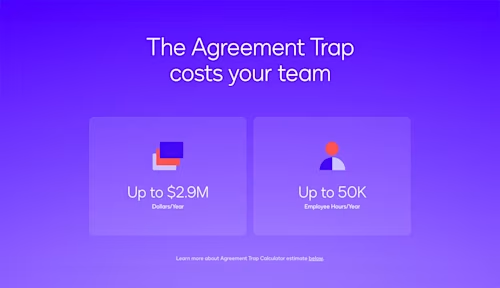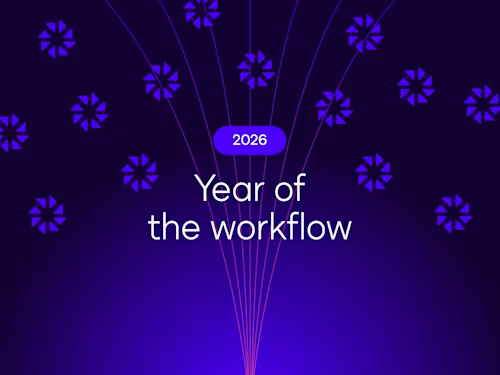
10 Ways the Agreement Trap Impacts Day-to-Day Work
Organizations around the world are losing almost $2 trillion a year in global economic value because of outdated agreement management tools and processes.

According to research done by Docusign and Deloitte, organizations around the world are losing almost $2 trillion a year in global economic value because of outdated agreement management tools and processes. We call that system of inefficiencies the Agreement Trap. It’s the price companies pay for sticking with the old way of creating, committing to, and managing agreements.
Two trillion dollars is a lot of money. That huge total accounts for missed opportunities, wasted time, and inflated operational costs. It touches every organization in every industry and every part of the world. Like it or not, your team probably has some outdated processes that contribute a few drops to that pool.
To help you ballpark exactly how much the Agreement Trap costs your team, we built an interactive assessment tool. All you have to do is answer a few questions about the agreement process for your team and the assessment will estimate how many hours and dollars your team is losing because of outdated workflows. It looks like this:

Even at the scale of your entire organization, it can be hard to understand the impacts of the agreement trap. It might be easier to grasp if you break it down into day-to-day problems you encounter that are caused by the Agreement Trap.
Here are 10 signs that your team is affected by the Agreement Trap, even if you don’t realize it:
B2B sales
1. Sales deals are constantly delayed.
At the beginning of your sales deals, sellers probably imagine a simple, straightforward agreement process. However, before the deal is finished, hurdles pop up—agreement templates go missing, data needs to be confirmed before manual entry, legal reviews take longer than expected, the contract requires additional rounds of review, a critical resource is out of office, etc. Ultimately, the deal gets pushed back a month, a quarter, or even longer. It may seem like these snags are just a part of the agreement process, but the truth is that these are problems that can be anticipated and avoided with the right technology. Those delays cost your team sales revenue. Individual sellers miss their quota and the team falls short of its revenue forecast. The inefficiency is also eating up time that could be spent working on new sales deals.
2. Agreements spend too long awaiting legal approval.
Legal teams have a lot on their plate. They’re usually a small team serving several different internal audiences. It’s common for busy legal approvers to turn into bottlenecks in the sales process. Agreements that seem like they’ll be quick and simple turn into long, complicated sagas with far too many obstacles. Your sales team doesn’t want that to happen. The legal team doesn’t like it either. It doesn’t have to be that way. Rather than involve costly legal resources in your routine agreement process, you should be looking for ways to automate common legal activities or even cut them out of the process by enabling sellers with preapproved self-service tools.
3. Price increases are not being enforced and collected.
Long-term sales contracts can often contain an upfront discount for customers. Those deals can be a great incentive to attract new customers. However, as the contract ages past those initial discounts, sellers often forget to apply the price increase and accidentally extend the lower price. Usually, the reason for those mistakes is a large based on agreements without an automated mechanism to enforce the agreed-upon terms. Because employees get too busy to search through completed agreements and find the correct amount for each billing period, the company misses out on revenue that is rightfully owed.
Procurement
4. Procurement employees don’t have time to manage vendors.
Do you wish you had more time to spend with vendors after you agree to a purchase with them? If you’re too busy establishing the terms of a relationship in the upfront purchase paperwork, you won’t have time to nurture it after the signature. That additional time with vendors ensures procurement teams can collect all purchased services or recover rebates if a vendor falls short. A healthier relationship could also result in better rates on future deals or more effective use of products.
5. Vendor contracts don’t contain standardized language.
When procurement agreements don’t all contain the same terms, each one has to go through its own unique review process. It has to be studied from beginning to end to make sure the language meets certain standards and doesn’t contain unnecessary risk. A better workflow would equip procurement teams with preapproved templates and clause libraries, letting them self-service and reducing the need for legal resources. It would make agreements move faster and let the team focus on vendor relationships instead of agreement processes.
6. You’re missing deadlines to renew agreements.
What systems does your team have in place to make sure you can renegotiate and renew agreements before they expire? Has an agreement ever slipped through the cracks of that system and expired before you could take action? When contracts are stored in different places and expiration dates are manually tracked in a spreadsheet, mistakes are bound to happen. Without an intelligent agreement management system to automate reminders and simplify renewals, your team could end up with surprise outages, accidental auto-renewals for services you don’t need, or rushed negotiations to get tools turned back on.
Human resources
7. Candidates are dropping out of your slow application process.
When you’re hiring, you’re competing with every other organization to attract the best talent. If the interview process moves too slowly or involves too many manual steps, quality candidates will lose interest. They’re not interested in reentering personal details on another form, they want to meet your team and learn about the job. When your application and interview process makes that difficult, the best talent goes elsewhere.
8. New hires take too long to onboard.
When your team is working short-staffed, it’s harder to meet business results and existing employees have to work overtime to fill in gaps. Those pains are even more acute when new employees have been found but are taking too long to tackle projects. If your HR team is still greeting new employees with a stack of paperwork and scanning copies of their IDs, you’re wasting time. New agreement systems can be set to trigger electronic versions of necessary documents as soon as a new hire starts. In some cases, they can even be completed before a new hire starts. When an employee spends days filling out long, duplicative onboarding documents, their first experience with the organization is negative. They’re also losing valuable time that would be better spent working with their new teammates.
Customer experience/consumer sales
9. Sales cycles are long because of complicated paperwork processes.
The shorter the sales cycles, the better. Customers have daily experiences that raise their expectations of what other companies should provide. They can be extremely sensitive to digital purchases and will quickly switch to a competitor who makes buying faster and easier. Onboarding agreements that eliminate in-person meetings and minimize time spent entering information are an enormous competitive advantage. Short sales cycles are also good for your company because money today is better than money tomorrow. Every extra day in your sales cycle is a double-edged sword, delaying your revenue and decreasing your conversion rate.
10. Customer service teams are taking too long to respond to requests.
When customers reach out to your team with a question about their account or their purchases, speed is imperative. That information is almost always contained in agreements. Your team needs to find the right answers and get back to them quickly. Inefficient teams can only serve a small number of customers well. The faster they get, the more productive they’ll be. The longer customers wait for answers, the more frustrated they are.
Even if you think your tried-and-true agreement process works perfectly, the truth is that there are new tools that could make it even better. If your team is suffering from any of the ten problems described in this post, the impact of an intelligent agreement management tool is probably bigger than you think.
Related posts
Docusign IAM is the agreement platform your business needs


